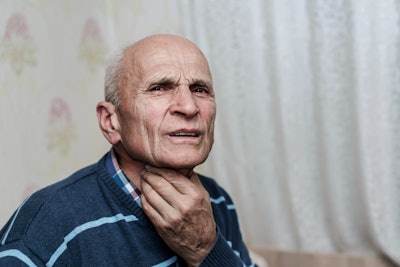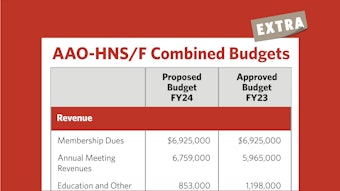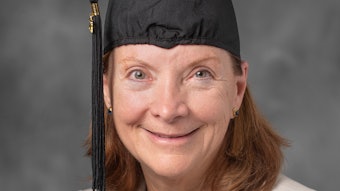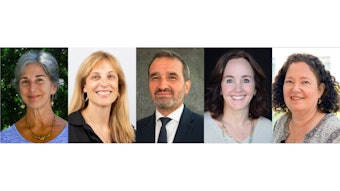Pearls in the Management of the Aging Voice
Otolaryngologists play a key role in successfully treating the aging voice, thereby contributing to a high quality of life in older individuals.
Ozlem E. Tulunay-Ugur, MD, and Karen M. Kost, MD, members of the Geriatric Otolaryngology Committee

The prevalence of dysphonia in the older population is estimated to vary from 12% to 35%.1-3 Although age-related dysphonia might have been seen as an expected part of aging in the past, it is now recognized as detrimental to the social well-being of older adults. With many older adults remaining in the workforce longer and using their voices professionally, dysphonia may impact both economic and social well-being.4 As such, the aging voice has gained increasing attention, with significant efforts directed at improving dysphonia in older adults.
Aging produces several alterations of the vocal tract. Some of the most important changes involve the pulmonary system, which is the power source of the voice. In addition to aging, concurrent comorbidities and intrinsic pathologies may also compromise pulmonary reserve. Poor pulmonary reserve leads to decreased subglottal pressures and reduced vocal loudness.5 Knowledge of the pulmonary status is important in counseling patients on management options and directly affects both medical and surgical outcomes. Indeed, one of the most important benefits of therapy is the positive effect it has on the coordination of voicing and respiration.6 In patients with asthma or chronic obstructive lung disease (COPD), reduced pulmonary reserve along with the chronic use of steroid inhalers may lead to inflammatory changes of the laryngeal structures. Other relevant extra-laryngeal changes affecting voice include atrophy of the salivary glands leading to xerostomia, atrophy of the mandible, and ill-fitting dentures negatively affecting speech production.
At the level of the larynx, important changes involve the musculature and lamina propria (LP). The thyroarytenoid muscles become weaker, thinner, and more fatigable with age.7 As muscle bulk decreases, there is reduction in myofibrils, increased collagen deposition, and decreased blood flow as well as fatty degeneration.8,9 Within the LP, the collagen fibers become disorganized, extra-cellular matrix production diminishes, the volume of hyaluronic acid (HA) decreases, and elastic fibers become amorphous and depleted.10,11 These changes lead to an edematous superficial LP and altered viscoelastic properties.2,11 The classical findings noted on laryngoscopy are a result of the above and include bowing of the true vocal folds, a spindle-shaped glottal gap, and prominence of the vocal processes.2,12 Stroboscopy may reveal aperiodic or irregular vibration, increased amplitude, mucosal wave asymmetry, and a midline glottal gap. These changes are known as presbylarynx and in some cases lead to the age-related voice changes termed “presbyphonia.” Acoustic features include reduced vocal intensity in speech, inability to project, decreased fundamental frequency in women and increased fundamental frequency in men, breathiness, and tremor. Generally, there is also secondary muscle tension dysphonia. Patients complain of vocal fatigue and an inconsistent vocal quality. Indeed, they often “do not know if they will have a voice,” resulting in anxiety and hindering social interactions. Presbyphonia, which frequently coexists with hearing loss, can lead to social isolation, depression, and even cognitive decline.
Presbylarynx is a diagnosis of exclusion. Other diagnoses may coexist and should be considered, especially if vocal fold movement is asymmetrical. Frequently reported laryngeal diseases include central neurologic conditions, benign vocal fold lesions, vocal fold paralysis/paresis, laryngeal carcinoma, and inflammatory disorders. Consequently, a full history and exam, including a comprehensive laryngostroboscopic examination, are an important part of the workup. Parkinson’s disease deserves special mention since it may present with laryngoscopic findings similar to those found in presbylarynx. Parkinson’s disease can lead to atrophy of the true vocal folds (TVFs), as well as a glottic gap on phonation, and is the most common neuromuscular disorder of the older population. Other findings include a monotonic speech quality with loss of pitch inflection and loss of stress (monoloudness). Patients generally also have a flat affect. One should be diligent in differentiating presbylarynx and Parkinson’s and obtain a neurology consultation accordingly, as voice changes may precede any of the motor symptoms.
Management of the aging voice requires a multi-disciplinary team, including an otolaryngologist, a speech language pathologist (SLP), a singing voice teacher, a physical therapist for full body conditioning, a nutritionist, and, ideally, a geriatrician. Most behavioral interventions provided by SLPs aim to optimize and balance the subsystems of voice production, improve glottal closure, and/or strengthen laryngeal musculature.13 Vocal function exercises (VFEs) and resonant voice therapy have been shown to positively affect laryngeal function and voice. Although direct evidence of the effects on thyroarytenoid (TA) muscle structure and morphology is lacking, the well-demonstrated benefits of vocal exercise strongly suggest a beneficial effect on the laryngeal musculature.4 In a recent systematic review, Bhatt et al. reported that although a variety of different interventions for age-related vocal fold atrophy may be beneficial, superiority of any particular intervention could not be established. They concluded that behavioral interventions might offer a potential advantage over surgical and procedural interventions because these treatments address respiratory support, resonance, and laryngeal function, all of which may contribute to symptoms. Behavioral intervention types, intensities, and durations varied widely between studies, making it difficult to determine an optimal behavioral intervention plan for comparison with procedural interventions.13
Common procedural interventions target closure of the glottal gap, mainly through augmentation of the TVFs either via injection laryngoplasty (IL) or thyroplasty. Various injectables including fat, HA, and calcium hydroxylapatite (CaHa) have been used with success. Fat injections must be performed in the operating room (OR), while commercially available injectables may be used in the office or OR. In-office procedures are a good option for older patients, especially if they are frail, oxygen dependent, or have cognitive problems that can worsen with general anesthesia or sedation.
Miaskiewicz et al., in reviewing their outcomes (HA or CaHa used), noted improved GRBAS (grade, roughness, breathiness, asthenia, strain ) scores for as long as 12 months in patients who underwent IL due to presbylarynx. On the other hand, while there was improvement in VHI scores, this did not reach statistical significance. Similarly, they only recorded improvement in fundamental frequency during objective acoustic measurements. There are varying reports on the duration of the benefits of IL. Although there are reports of benefits lasting 12 months, or even up to two years, other studies show deterioration after three months. Reiter et al. observed significant improvement in hoarseness, breathiness, and roughness up to 12 months post augmentation in patients who had a smaller mean preoperative glottal gap of 1.1 mm. They did not observe improvement six months post injection in patients with larger mean gaps of 2.8 mm. Consequently, the size of the glottal gap may help guide the decision on whether to offer IL versus thyroplasty. Finally, it should be noted that CaHa can lead to stiffness of the true vocal folds and for professional voice users, thyroplasty may be a better option.14
Thyroplasty, with either silicone or GORE-TEX, has been successfully used in the management of the aging voice. Sachs et al. reported comparable outcomes between IL and GORE-TEX thyroplasty but better self-reported voice outcomes in the thyroplasty group.15 Other studies have validated the use of thyroplasty in presbylarynx. Although the choice of implant is surgeon dependent, GORE-TEX is generally considered easier to learn and is associated with shorter operating times. There have been concerns, however, that with GORE-TEX there may be some decline in vocal outcomes over time.
Studies continue to evaluate the role of tissue engineering and rejuvenation. Improved glottal gap and decreased atrophy in human vocal folds were reported with injections of hepatocyte growth factor (HGF). Hirano and his group have reported on the use of fibroblast growth factor (FGF) and HGF. Studies assessing tissue engineering techniques and the use of scaffolds are generating a great deal of interest and are currently underway.16,17
In conclusion, older patients make up the fastest growing part of the population and will be seen increasingly frequently in our clinics. They constitute an important part of the workforce and greatly value a high quality of life. Vocal quality is an important part of quality of life and plays an integral role in cognitive health, social integration, and productivity. As otolaryngologists, we are in the privileged position of being able to understand and successfully treat the aging voice, thereby contributing to a high quality of life in older individuals.
References
- Hagen P, Lyons GD, Nuss DW. Dysphonia in the elderly: diagnosis and management of age-related voice changes. South Med J. 1996;89:204-207.
- Pontes P, Brasolotto A, Behlau M. Glottic characteristics and voice complaint in the elderly. J Voice. 2005;19:84-94.
- Morrison MD, Gore-Hickman P. Voice disorders in the elderly. J Otolaryngol. 1986;15:231-234.
- Kost KM, Sataloff RT. Voice disorders in the elderly. Clin Geriatr Med. 2018;34:191-203.
- Johns MM III, Arviso LC, Ramadan F. Challenges and opportunities in the management of the aging voice. Otolaryngol Head Neck Surg. 2011;145:1-6.
- Nagai H, Ota F, Konopacki R, Connor NP. Discoordination of laryngeal and respiratory movements in aged rats. Am J Otolaryngol. 2005;26:377-382.
- McMullen CA, Andrade FH. Contractile dysfunction and altered metabolic profile of the aging rat thyroarytenoid muscle. J Appl Physiol. 2006;100(2):602-608.
- Kahane J. Connective tissue changes and their effects on voice. J Voice. 1987;1:27-30.
- Lyon MJ, Malmgren LT. Age-related blood flow changes in the rat intrinsic laryngeal muscles. Acta Otolaryngol. 2009:1-5.
- Abdelkafy WM, Smith JQ, Henriquez OA, et al. Age-related changes in the murine larynx: initial validation of a mouse model. Ann Otol Rhinol Laryngol. 2007;116:618-622.
- Sato K, Hirano M. Age-related changes of elastic fibers in the superficial layer of the lamina propria of vocal folds. Ann Otol Rhinol Laryngol. 1997;106:44-48.
- Honjo I, Isshiki N. Laryngoscopic and voice characteristics of aged persons. Arch Otolaryngol Head Neck Surg. 1980;160:149-150.
- Baertsch HC, Bhatt NK, Giliberto JP, et al. Quantification of vocal fold atrophy in age-related and Parkinson's disease–related vocal atrophy. Laryngoscope. 2022;133(6):1462-1469.
- Miaskiewicz B, Panasiewicz-Wosik A, Nikiel K, et al. Injection laryngoplasty as an effective treatment method for glottal insufficiency in aged patients. Am J Otolaryngol. 2022;43:1-8.
- Sachs AM, Bielamowicz SA, Stager SV. Treatment effectiveness for aging changes in the larynx. Laryngoscope. 2017;127:2572–2577.
- Hirano S, Bless DM, del Rio AM, et al. Therapeutic potential of growth factors for aging voice. Laryngoscope. 2004;114:2161-2167.
- Hirano S, Nagai H, Tateya I, et al. Regeneration of aged vocal folds with basic fibroblast growth factor in a rat model: a preliminary report. Ann Otol Rhinol Laryngol. 2005;114:304-308.


















